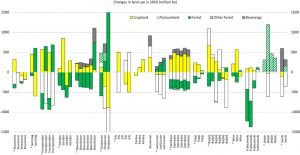Agricultural activities on croplands and pastures occupy 11% and 26% of earth surfaces, respectively, while forests comprise 31% of the earth’s surface (FAOSTAT, 2016). Global cropland and pasture areas have increased by 110% and 59%, respectively, from 1850 to 2015, while the area of global forest decreased by 17% (Houghton and Nassikas, 2017). Native lands and non-forest ecosystems (e.g. grasslands or shrub lands) were also cleared at the expense of agricultural lands over this period (Houghton and Nassikas, 2017). Agricultural land use and expansion have been identified as primary drivers of forest loss and degradation throughout the globe, ranging from subtle modification of natural forest to extensive deforestation (Clark et al., 2012) particularly in tropical regions (Gibbs et al., 2010; Keenan et al., 2015; Song et al., 2018). In addition to agricultural activities, timber and fuelwood extraction contribute to forest loss and degradation. Natural forests are increasingly converted to managed forests which amount to 278 million ha worldwide, out of 3999 million ha of the total global forest area in 2015 (FAO, 2015; Keenan et al., 2015). Managed forestry may replace natural forests but will also encroach on abandoned agricultural land, leading to competition with other land uses.
Read the full article here.
